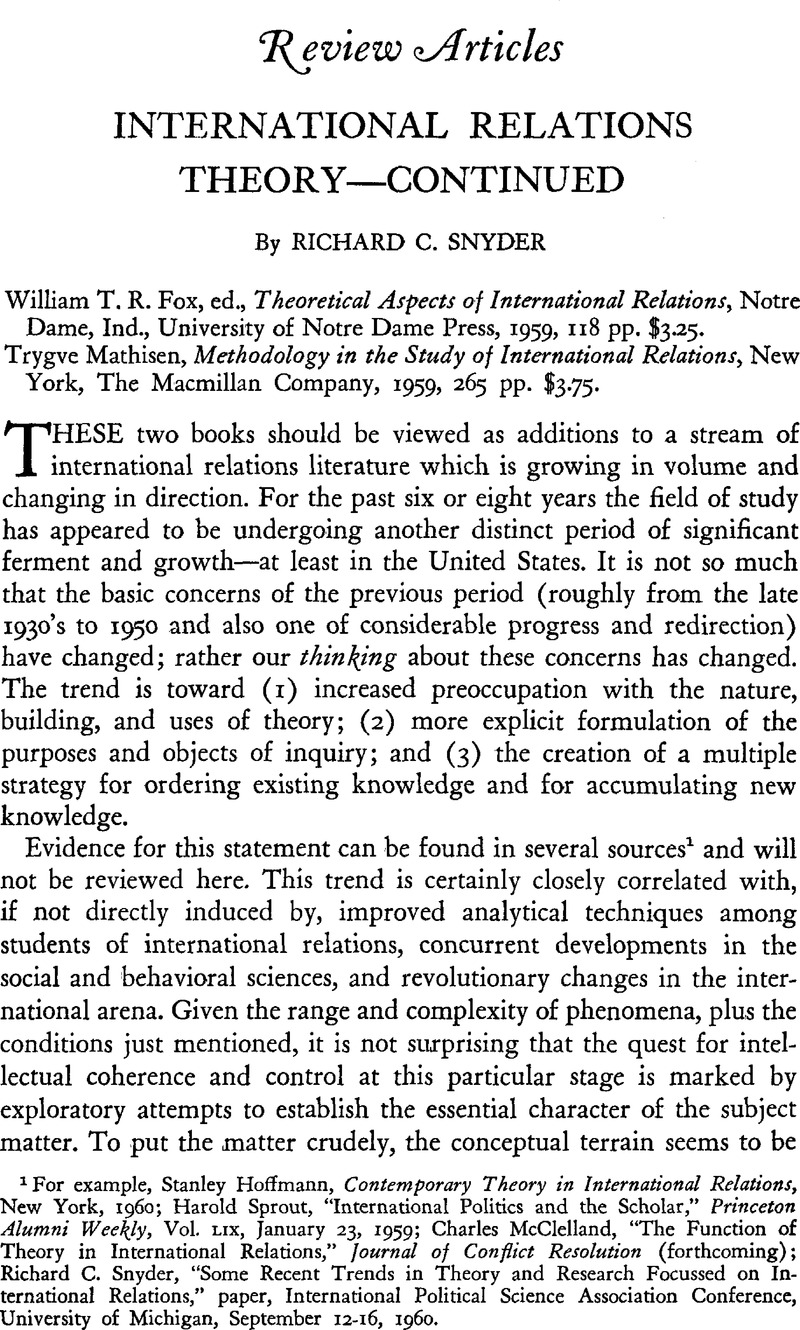Article contents
International Relations Theory—Continued
Review products
Published online by Cambridge University Press: 18 July 2011
Abstract

- Type
- Review Articles
- Information
- Copyright
- Copyright © Trustees of Princeton University 1961
References
1 For example, Hoffmann, Stanley, Contemporary Theory in International Relations, New York, 1960Google Scholar; Sprout, Harold, “International Politics and the Scholar,” Princeton Alumni Weekly, Vol. LIX, January 23, 1959Google Scholar; Charles McClelland, “The Function of Theory in International Relations,” Journal of Conflict Resolution (forthcoming); Snyder, Richard C., “Some Recent Trends in Theory and Research Focussed on International Relations,” paper, International Political Science Association Conference, University of Michigan, September 12–16, 1960.Google Scholar
2 George Schwarzenberger is an exception; see his Power Politics, London, 1941. See also Corbett, Percy, Law and Society in the Relations of States, New York, 1951Google Scholar; Gross, Feliks, “The Sociology of International Relations: Research and Study,” International Social Science Journal, XII, No. 2 (1960), pp. 269–76.Google Scholar
3 The anthropological term is perhaps more properly a segmentary society.
4 Vine, Robert A. Le, “Problems in the Study of Stateless Societies,” paper, Central States Anthropological Society, 1959.Google Scholar
5 Glock, Charles Y., “Issues That Divide: A Postscript,” Journal of Social Issues, No. 3 (1956), pp. 3–11.Google Scholar
6 Politics Among Nations, New York, 1956; Scientific Man vs. Power Politics, Chicago, 1946.
7 Man, the State, and War, New York, 1959.
8 The Structure of Nations and Empires, New York, 1959.
9 The question: Is international relations a discipline? does not necessarily lead to fruitful discussion when it is taken literally.
10 In this particular essay, Morgenthau regards international relations and international politics as synonymous.
11 The War Potential of Nations, Princeton, N.J., 1956.
12 Man-Milieu Relationship Hypotheses in the Context of International Politics, Center of International Studies, Princeton University, 1956.
13 “The Balance of Power: Prescription, Concept, or Propaganda?” World Politics, V, No. 4 (July 1953), pp. 442–77.
14 Dahl, Robert A., “The Concept of Power,” Behavioral Science, II, No. 3 (July 1957), pp. 201–15Google Scholar; Simon, Herbert, “Notes on the Observation and Measurement of Political Power,” Journal of Politics, XV, No. 4 (November 1953), pp. 500–16CrossRefGoogle Scholar; March, James G., “An Introduction to the Theory and Measurement of Influence,” American Political Science Review, XLIX, No. 2 (June 1955), pp. 431–51CrossRefGoogle Scholar; French, John, “The Bases of Social Power,” in Dorwin Cartwright, ed., Studies in Social Power, Institute for Social Research, University of Michigan, 1959.Google Scholar
15 Sullivan, Denis, “The Concept of Power in International Relations,” paper, Mid-west Conference of Political Scientists, Bloomington, Ind., April 29, 1960.Google Scholar
16 “Scientific International Politics,” World Politics, XI, No. 1 (October 1958), pp. 83–86.
17 The Strategy of Conflict, Cambridge, Mass., 1960.
18 Snyder, , op.cit., pp. 141–16Google Scholar; McClelland, , op.cit., esp. pp. 38ff.Google Scholar
19 “International Relations: The Long Road to Theory,” World Politics, XI, No. 3 (April 1959), pp. 346–77.
20 Kaplan, Morton A., System and Process in International Relations, New York, 1957Google Scholar; Haas, Ernst B., “The Comparative Study of the United Nations,” World Politics, XII, No. 2 (January 1960), pp. 298–322.CrossRefGoogle Scholar
21 Campbell, Donald, “Common Fate, Similarity, and Other Indices of the Status of Aggregates of Persons as Social Entities,” Behavioral Science, III, No. 1 (January 1958), pp. 14–25.Google Scholar
22 Guetzkow, Harold, “Conversion Barriers in Using the Social Sciences,” Administrative Science Quarterly, IV, No. 1 (June 1959), pp. 68–81.CrossRefGoogle Scholar
- 1
- Cited by


